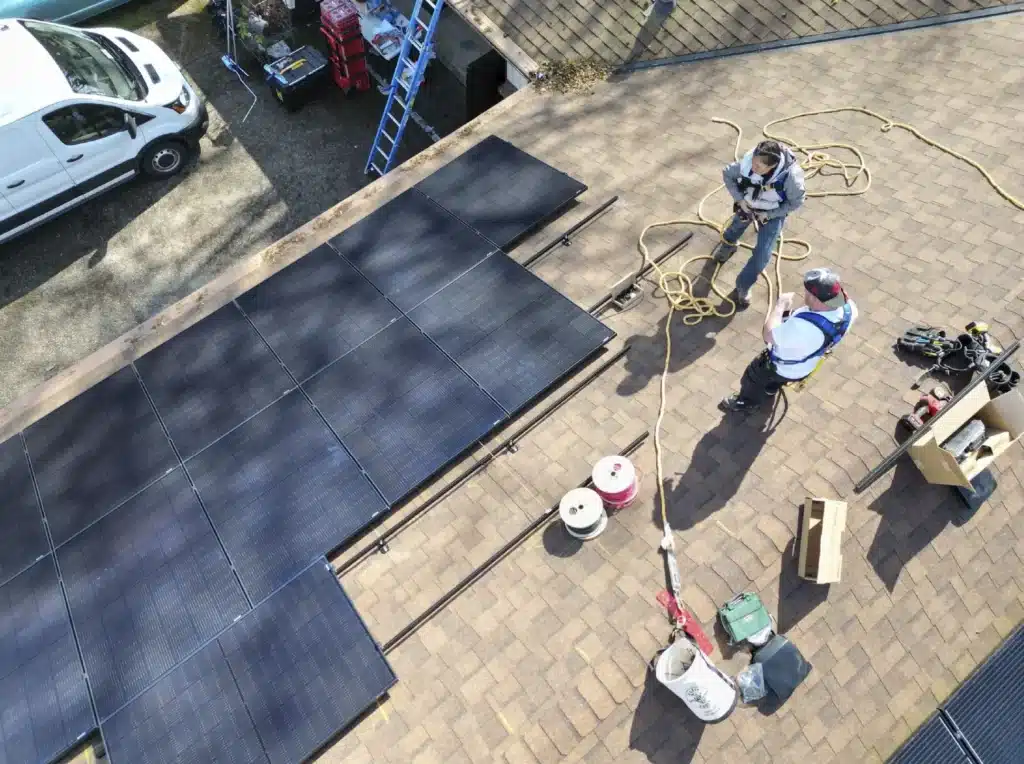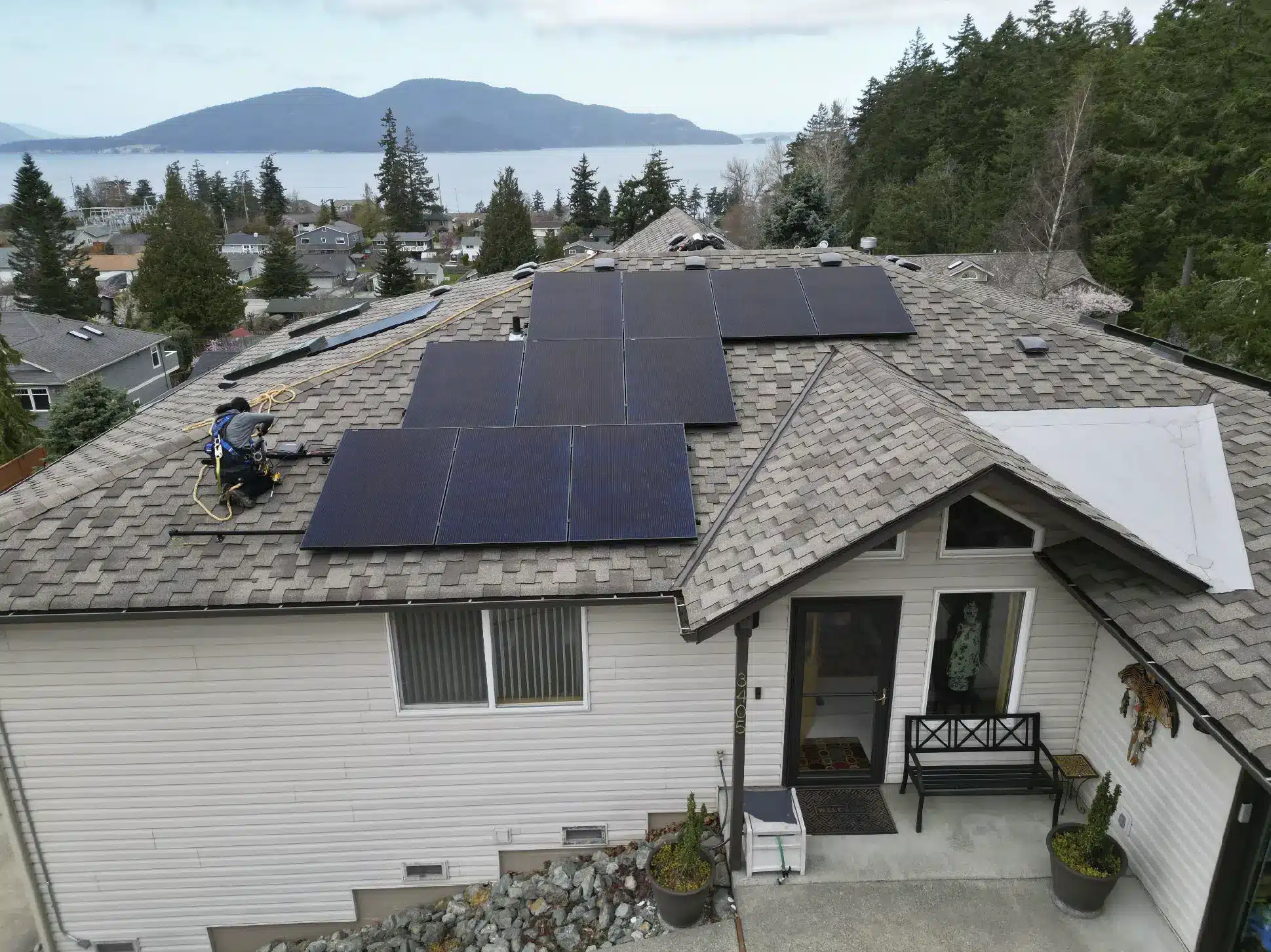Solar panels, especially when paired with a battery backup, offer lower electricity bills, energy independence, and positive environmental impacts. The popularity of solar energy is on the rise due to these benefits for homeowners.
If you’re interested in solar panels for your home, we’ve created this comprehensive guide, including information about the operation, types, costs, and benefits. With these aspects in mind, you can make an informed decision when installing a solar energy system.
Understanding Solar Panels: How They Work
Solar panels convert sunlight into electricity through the photovoltaic (PV) effect. Each panel contains photovoltaic cells (also known as solar cells) made from semiconductor materials, typically silicon. When sunlight hits these cells, photons excite electrons, freeing them from atoms and creating an electric field that generates direct current (DC) electricity.
However, solar panels don’t work alone—they require several key components for a complete solar energy system. A mounting system secures panels in place to capture the most sunlight and withstand weather conditions. In the Pacific Northwest, where strong winds and storms are common, special attention is given to wind loads when designing the racking and mounting system to ensure structural integrity and long-term performance.
The inverter converts the DC electricity produced by solar panels into alternating current (AC), which powers homes and is compatible with the electrical grid. Some inverters also optimize energy output and regulate voltage. Battery storage, while optional, allows homeowners to store excess solar energy for use at night, during power outages, or when sunlight is limited, reducing dependence on the grid.
When properly installed and optimized, a solar energy system maximizes solar panel efficiency, lowers electricity costs, and enhances energy independence.
Types of Solar Panels: Which is Right for Your Home?
When selecting solar panels for your home, there are three main types: monocrystalline, polycrystalline, and thin-film. Each offers unique benefits depending on efficiency, aesthetics, and installation needs.
Monocrystalline panels are the most efficient, converting a higher percentage of sunlight into usable electricity. Their sleek, dark appearance blends well with most rooftops, making them a popular choice for homeowners prioritizing both performance and aesthetics.
Polycrystalline panels have a more noticeable blue hue and offer a balance between efficiency and affordability. While they generate slightly less power per square foot than monocrystalline panels, they remain a solid option for those looking to reduce upfront costs. Thin-film solar panels are lightweight and flexible, making them ideal for non-traditional surfaces where standard panels may not be suitable.
How many solar panels you need depends on the type of solar panels, your available space, and your energy consumption. If you have limited roof space and want maximum efficiency, monocrystalline panels are the best choice. For a cost-effective option with moderate efficiency, polycrystalline panels provide a practical alternative. If your property requires a flexible installation solution, thin-film panels can be a great fit.
How Much Do Solar Panels Cost?
As of January 2025, the average cost for a solar panel system is $2.58 per watt. For a 9-kilowatt (kW) system, this translates to an estimated total cost of $32,330 before incentives or tax credits. However, pricing can vary based on system size, panel type, and installation complexity.
Beyond the cost of the panels themselves, installation expenses include labor, mounting equipment, and electrical work, which depend on factors such as roof type, permitting requirements, and the expertise of your solar installer.
Investing in solar is a smart financial decision that provides long-term savings on electricity bills, protection from rising energy costs, and increased home value. To determine the best solar solution for your home, consulting a trusted local solar provider is the key to maximizing benefits.
To make the solar panel installation cost more affordable, homeowners can take advantage of specialized clean energy loans offered by credit unions and financial institutions. Many credit unions provide financing designed specifically for solar and energy-efficient home improvements, often with lower interest rates and flexible terms compared to traditional loans.
Solar energy is a high-return investment, with most homeowners seeing a payback period of 5 to 15 years. By utilizing clean energy loans, homeowners can transition to solar power more easily, reducing electricity costs, increasing property value, and achieving long-term energy independence.
Benefits of Going Solar: More Than Just Savings
The biggest draw to solar power for many homeowners is lower energy bills. Yet, that’s only the surface. Solar systems also offer increased property value, reduced carbon footprints, and energy independence when paired with battery backup systems.
There are also many local incentives for using renewable energy. Some Washington solar incentives include tax credits, sales tax waivers, and net metering. If you live in another state, check to see what your options are. These incentives can help save money on solar installation and offset or even eliminate electricity bills.
Installation Process: From Consultation to Powering Your Home
Transitioning to solar power is a straightforward process when guided by experienced professionals. From the initial consultation to flipping the switch on your new system, each step is designed to ensure optimal performance and long-term reliability.
- Expert solar energy providers will conduct a comprehensive site assessment, evaluating your home’s sun exposure, roof structure, and energy needs.
- Next, they’ll design a custom solar and battery backup system tailored to maximize efficiency in the region’s unique climate.
- The solar installer will obtain the necessary permits, ensuring compliance with local regulations and utility requirements.
- Skilled technicians carefully mount the solar panels, integrate the inverter and battery backup, and connect the system to your home’s electrical panel. The process typically takes one to three days.
- After installation, the system undergoes rigorous testing and inspection to confirm everything is operating at peak performance.
Choosing the right company for residential solar installation is essential to a smooth experience. Homeowners in the greater Seattle area should look for solar professionals with a strong reputation, deep regional expertise, and a commitment to customer service. A trusted provider like Clean Energy Innovators, with over 20 years of experience in complex solar and battery systems, ensures your installation is designed for maximum energy savings, resilience, and efficiency—perfect for the demands of Puget Sound’s climate.
Solar Maintenance and Longevity: Keeping Your Panels Efficient
Luckily, solar panels require little maintenance. However, if you notice something affecting the efficiency, it’s best to tackle it early on. If any leaves, dirt, and debris build up on the panels, they could convert less sunlight, so it’s important to remove obstructions.
You can pair a maintenance app with your solar panels to detect concerns. If the app finds a problem area or if your panels need repairs, contact solar experts to help with specialized maintenance. Solar panel warranties typically range from 10 to 25 years, but by addressing problems as they arise, these systems can last much longer.
Common Myths About Solar Panels Debunked
There are lots of misconceptions about solar panels for your home. One of the most common is that solar only works when the sun is shining. While maximum sunlight can improve efficiency, some sunlight still reaches the earth on cloudy days. Plus, pairing your solar panels with battery backups can store excess energy to keep your lights on even during days when solar panels are less efficient.
Another misconception is that solar is too expensive. While the upfront costs of panels and their installation can be pricey, there are financing options and local incentives to help with that. Solar systems also have a great return on investment because of the money you’ll save on electric bills.
Finally, many people assume that it’s difficult to resell homes with solar systems. In most cases, buying solar panels will increase a home’s value by 6.8%, making homes more desirable than they were before.
Start Your Solar Journey Today
To experience the lower bills, energy independence, and environmental impact of solar systems, contact an expert solar energy provider to get started. Anyone looking to buy solar panels for homes in the Seattle area should consider Clean Energy Innovators, a trusted installer with over 20 years of experience.
Take the first step toward energy independence—get your free solar quote today!


